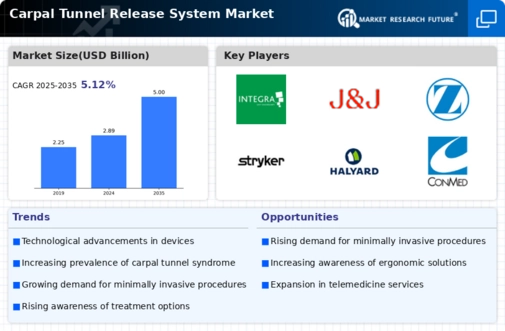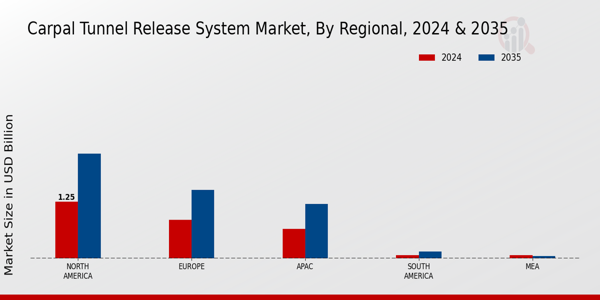Growing Geriatric Population
The aging population is a significant driver for the Carpal Tunnel Release System Market. As individuals age, the likelihood of developing musculoskeletal disorders, including CTS, increases. The World Health Organization projects that the number of people aged 60 years and older will double from 12% to 22% between 2015 and 2050. This demographic shift is expected to lead to a higher demand for medical interventions, including carpal tunnel release systems. Healthcare systems are increasingly focusing on addressing the needs of older adults, which may result in enhanced funding and resources allocated to treat conditions like CTS. Consequently, the Carpal Tunnel Release System Market is poised for growth as the geriatric population expands.
Rising Awareness and Education on CTS
The increasing awareness and education surrounding Carpal Tunnel Syndrome (CTS) are pivotal drivers for the Carpal Tunnel Release System Market. Public health campaigns and educational initiatives by healthcare organizations are informing individuals about the symptoms and treatment options for CTS. This heightened awareness encourages patients to seek medical advice sooner, leading to earlier diagnosis and intervention. Data suggests that early treatment can significantly improve outcomes, which may drive the demand for carpal tunnel release systems. As more individuals become educated about CTS, the market is likely to experience growth, as patients actively pursue effective solutions for their condition.
Increased Focus on Occupational Health
There is a growing emphasis on occupational health and safety, which is driving the Carpal Tunnel Release System Market. Employers are becoming more aware of the impact of repetitive strain injuries, such as CTS, on workforce productivity and employee well-being. As a result, many organizations are implementing ergonomic assessments and preventive measures to reduce the incidence of CTS among employees. This proactive approach not only helps in minimizing workplace injuries but also leads to increased demand for effective treatment options when injuries do occur. The Carpal Tunnel Release System Market stands to benefit from this trend as companies seek to provide comprehensive care for their employees, including surgical interventions when necessary.
Rising Prevalence of Carpal Tunnel Syndrome
The increasing incidence of Carpal Tunnel Syndrome (CTS) is a primary driver for the Carpal Tunnel Release System Market. As more individuals engage in repetitive tasks, particularly in office environments and manufacturing, the number of diagnosed cases of CTS continues to rise. According to recent data, approximately 3% to 6% of the population may experience symptoms of CTS at some point in their lives. This growing prevalence necessitates effective treatment options, thereby propelling the demand for carpal tunnel release systems. Furthermore, as awareness of CTS increases, more patients are seeking medical intervention, which further stimulates market growth. The Carpal Tunnel Release System Market is thus positioned to expand as healthcare providers adopt innovative solutions to address this common condition.
Technological Advancements in Surgical Techniques
Technological innovations in surgical techniques are significantly influencing the Carpal Tunnel Release System Market. The advent of minimally invasive procedures, such as endoscopic carpal tunnel release, has transformed the treatment landscape. These techniques offer reduced recovery times and lower complication rates, making them more appealing to both patients and healthcare providers. Data indicates that minimally invasive surgeries can reduce hospital stays by up to 50%, which is a compelling factor for patients considering surgery. As surgical technology continues to evolve, the market is likely to see an increase in the adoption of these advanced systems, thereby enhancing the overall efficiency and effectiveness of carpal tunnel release procedures.


















Leave a Comment